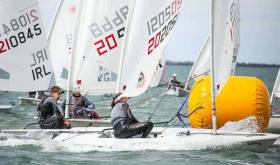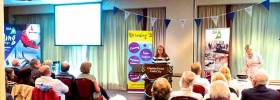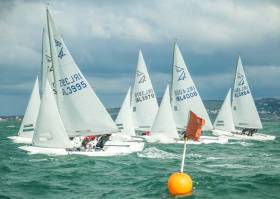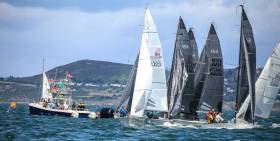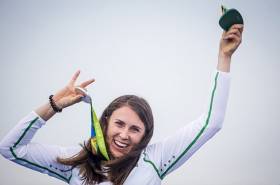Displaying items by tag: ISA
Annalise Murphy To Share Expertise At ISA Youth Sailing Championships in Northern Ireland
Annalise Murphy is just one of four evening talks taking place at the ISA Youth Sailing National Championships, being held at Ballyholme Yacht Club, 19-23 April. As Afloat.ie reported previouslty, it is the first time the event has been sailed in Northern Ireland.
The evening talks as well as the races are open to all young sailors who sail in the five ISA Youth Pathway Classes (Laser Radial, Laser 4.7, 420, Topper, Optimist). This is Ireland’ largest Youth regatta and the ISA’s primary talent spotting event of the year for the Academy and Junior classes. The ISA squad programmes will resume this summer in the Laser 4.7 and Topper classes, and these classes will have a squad trial to identify future ISA Pathway sailors. In addition, ISA spotters are out to assess sailors for Academy trials for the Laser Radials and 420s. (The Optimists will have separate Class-organised talent spotters).
Eight places on the ISA Topper Squad
In the Topper class up to eight sailors will be selected to join the ISA Topper Squad. The Squad coach and programme will be announced following the event. The programme aimed at developing young Topper sailors will provide training and also support at the 2017 Topper World Championship to be held in Brittany, France in July. Entry to the World championship is independent of ISA squad selection and through the International Topper Class Association.
Five places on the ISA Laser 4.7 Squad
Up to five sailors will be chosen at the ISA Youth Pathway Nationals to join the ISA 4.7 Squad. A further two sailors may be chosen at the 2017 Laser 4.7 Ulster Championship. The ISA 4.7 squad will provide training to help young sailors transition in the Laser 4.7 class. It will also aim to prepare and support the squad for the Laser 4.7 World Championship to be held in Nieuwpoort, Belgium in July. The squad coach and programme will be announced following event. Entry to the 4.7 Worlds is independent of ISA squad selection through the International Laser Class Association.
A line–up of big name evening speakers – including Annalise Murphy – open to all:
At 5.30pm each evening there will be a talk and Q&A session at the Ballyholme Yacht Club with speakers who have a deep knowledge of racing. The talks are open to all sailors and parents.
Full list of Evening Speakers:
Wednesday 19th April, BILL O'HARA will discuss “What to consider when preparing for an event - Rules Strategy for racing”. Bill is the current Principal Race Officer for the Volvo Ocean Race, International Umpire and Rules adviser to the Irish Olympic Team.
Thursday 20th April, Annalise Murphy (Olympic Silver medalist) will share her insights in a talk entitled “Beat the Best: Preparing for Competitive Gains at the Olympics”.
Friday 21st April, Matt McGovern (Double Olympian 49er Class) will talk on “Team Work in Sailing – Preparing a Professional Approach”
Saturday 22nd April, Ross Killian & Russell McGovern (ISA Performance Coaches) will give video analysis and coaching tips from the day’s racing.
ICRA Debate – Running The Rule Over IRC & ECHO Handicaps
The Irish Cruiser Racing Associaton (ICRA) has called for debate about the future direction of Irish cruiser–racing at Saturday's national conference in Limerick. Here, Brian Turvey makes his contribution by describing how IRC and ECHO rating systems work in Ireland and why there is concern over the availability of free handicapping software. The former Howth Yacht Club Commodore asks how ICRA can capture all cruiser-racing boats and add value to the sport because, he says, the future of cruiser-racing relies on ICRA starting to think more creatively.
Most racing sports appear relatively straightforward to the uninitiated and only reveal new layers of complexity as you become more involved and enthused to watch or participate. Consider Formula One racing, it seems straightforward - scream around the course faster than anyone else and you win. Horse racing in Britain now boasts that more than 60% of their sport is now categorised as handicapped, a departure from the principle of 'first past the post' by adding weights in a calculated effort to reinforce what is considered to be a sport of chance and potentially allow any horse and consequently any punter to win.
Then consider the sport of yacht racing, commonly recognised to be the most complicated sport to learn and there is little dispute that it is the most complicated of all to follow. Most sailors have attempted a well-intentioned explanation of the sport to a non-sailor, but very few are gifted with the skill to articulate it and fewer manage to retain the attention and interest of even the most fervent of enquirers.
But explaining the concept of yacht racing is only the first layer. Now add the much-used rating handicap systems. The goal of trying to narrow and equalise the finishing time of all competitors in a race is common to lots of sports and based on a measurement calculation, the first version was standardised in yacht racing during the 19th century. There have been many variants and evolution of the original formula and rule, with the dinghy-measurement version 'Portsmouth Yardstick' (PY) being the winner for longevity.
 Mixed dinghies race under a Portsmouth Yardstick rule
Mixed dinghies race under a Portsmouth Yardstick rule
Endorsed by ICRA and the Irish Sailing Association (ISA), the system currently preferred by more than 7000 boats worldwide including most Irish and British yachts is the RORC's 'IRC Rating.' Closely monitored by yacht designers and engineer-types, it is essentially a formula that uses various boat measurements to calculate a rating number. When each rating is applied to every boat in a race and all other factors being equal, the factor-adjusted elapsed time should have every boat finish equal, or so the concept should work. And it does, for the most part. The theory and practice would be that those crews who best optimise their performance during the race, will win.
But as the designers get smarter and yesterday's yacht tumbles in value (unlike racehorse ownership, this is not a speculative investor's arena), the rule-masters in the RORC have to stay alert and agile to keep pace and keep relevant for their broad range of customers. However, they will always be 'followers', at best reacting a-season-too-late to those design enhancements that would otherwise render older racing designs obsolete much faster than their owners would stand for.
One-design sailors tend not to understand the attraction and complexity of IRC racing, by preferring to gravitate towards a class that offers localised 'critical mass' that might promise solid investment in relative terms and suggest many years sailing in a vibrant and competitive class. Which is all fine and dandy, but the leading edge of design development will more often be tested and refined in 'mixed-design' racing. Designers such as Mills and Corby revel in the challenge of one-off racing yachts, while the production-line manufacturers like Jeanneau and X-Yachts have to stay sharp with their designs, because producing anything less than competitively-rated racing boats from a production line would be calamitous.
So buying a well-rated IRC cruiser-racer is a bit like committing to the latest gadget, it will be out-performed in no time by the next best thing, albeit with some notable exceptions. What then for the enthusiastic racing owner of an older or lesser-rated design? Giving 5 minutes per hour to boats that frequently cross the line ahead of them will wear the enthusiasm for the sport from owner and crew in no time. There is a safety net and it is in the form of the next layer of complexity in cruiser-racing: Performance-Rated Handicapping.
Built under the guidance of the then ISA President Paddy O’Neill, ECHO (East Coast Handicap Organisation) was created by a team of Irish amateur sailors including Ernest Gouding, Hal Silk, Billy Lacy, Chris Bruen, Arthur Barker, John Deane and Chick Brown who all brilliantly blended their interest in sailing with their maths skills. The system has grown to be the main performance-based cruiser racing handicap system in Ireland and has in recent years been adopted and adapted internationally alongside measurement rating systems such as IRC and ORC.
With help from the Dublin Bay Sailing Club’s Brian Barry, it was integrated into a unique database-structured sailing results system built by Colin McMullen for DBSC and Howth Yacht Club. Colin had the distinction of being the only professional computer programmer in the world who was a sailor. ECHO, which was known in certain circles as as ‘Earnest, Chris Hal and Others’, is best compared to handicapping in horseracing, but by adjusting the elapsed time instead of saddlebag weight.
Calculated by and based on previous performance history, the formula calculates a rating for every boat that should have all boats finish on equal time. Whilst this desired end-point is similar to that of the measurement-based rating, it has a very different rationale. ECHO is designed to reward crews that out-perform their recent average results. The theory being that any boat can win, relative to their own performance history. The actual specification and design of boats is irrelevant and in theory, the slower and obsolete designs now have every chance of winning under ECHO. The ‘lower end’ of the fleet have something to race for, encouraging crew on the lesser competitive boats, eliminating the ‘what's the point’ factor, whilst maintaining and encouraging participation. Everyone's a winner, well perhaps not quite...
For ECHO to work optimally as per the concept, it relies on 'consistency' and all the possible variables need to be removed, or minimised at worst.
• The same boats and same number of boats must be continually racing against each other in each race. Every deviation in numbers competing and/or infrequent entries will alter all boats handicaps accordingly. This makes it at best very difficult, but normally impossible to assign initial handicaps to a mixed fleet of boats that haven’t recently nor regularly raced together. In these circumstances a ‘link’ boat is used where there is found to be a record of it racing against the other boats before, but it rarely works, because ECHO works best with local fleets.
• ECHO's focus is on the relative difference in performance of a boat (particularly the crew), so a change in personnel will often alter performance and therefore another variable is introduced. It should be noted that there is an obligation on boats racing under ECHO to declare substantive changes to crew, but in practice, most changes go 'under the radar' and rarely get declared.
• Any variation from the average/normal in weather conditions will affect the mean calculations. For example, lighter than average winds might favour the lighter displacement boats.
• Any alteration in the type of course (from the average) will introduce another variable. Different boat designs will vary in performance on specific up wind, downwind and reaching legs.
• There is also the issue of 'sandbagging' or deliberately underperforming in order to reduce ECHO rating and use this in the next or later race to advantage. This is very difficult to prove in competitive fleets, because a boat can lose places very easily and in genuine circumstances.
The ECHO administrators allow direct manual intervention to address anomalies such as these, but a results system that affords interpretive adjustments could be seen to be subjective and potentially ambiguous. Single race regattas are the most problematic, where new boats are added without previous integration in that fleet. Interestingly, it seems to work in the potentially controversial sport of horse racing without complaint.
ECHO is often erroneously compared to a golf handicap, but has little in common other than being performance-related. Golf handicaps are not derived from team performance, it is one person versus the course and the other competitors have neither influence on nor an ability to intentionally affect an opponent's score. Golf is not a race. Performance-rated yacht racing is almost always a team-sport, where with certain probability, every race will mean a change in performance by at least one boat, necessitating handicap revisions to all.
The step towards ‘progressive’ maintenance of ECHO handicaps was a welcome one for racing sailors that embrace the performance handicap, because it readjusts after every race. (ECHO used to only adjust periodically, often causing consternation in fleets by huge changes happening at one time.) However, as a consequence of this, it is almost impossible for an experienced and ECHO–savvy competitor to determine their actual standing during a race – what must it be like for the newbie or spectator? Whatever the difficulty with deducing the standings during an IRC race, performance handicap races are absolutely not spectator events.
But to be stressed out about the accuracies and anomalies of this system is futile. It will raise the passions of many a sailor, particularly when a calculation seems to produce an unfair result. Like measurement ratings, ECHO handicapping is not a pure science, but with the probability of so many variables, sailors need to know that it is always imperfect.
With the development of relatively simple sailing results software and the adoption of ECHO-type systems by sailing clubs and classes across the world, it is now possible to use this software for most sailing events and club racing. Lots of one-design classes have effortlessly added performance handicap prizes to their traditional ‘scratch’ races and events. Club volunteers who are using software packages such as Sail 100, SailWave and Top Yacht can now set up performance handicapping for dinghies, one-design keelboats and for cruiser racing in addition to providing results for Scratch, PY and IRC. This is now an attractive proposition for many clubs, because performance handicapping works best for local fleets where the same boats and sailors race together frequently.
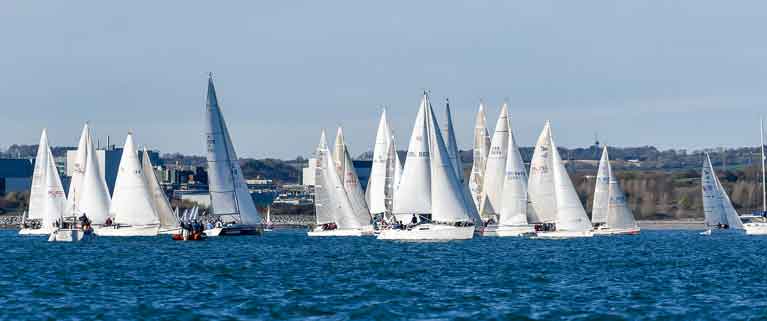 A wide range of different cruiser and sportboat types combine for all-in club racing. Photo: Bob Bateman
A wide range of different cruiser and sportboat types combine for all-in club racing. Photo: Bob Bateman
So how might this affect the future for ECHO in Ireland? The ‘elephant in the room’ and big consideration for the ISA and ICRA is that ECHO-type software programmes are now freely available and ideal for local club racing. Why then might a regional club or class need to use or pay for ECHO? It will naturally be conditional that the major regattas such as Volvo Dun Laoghaire and the ICRA Nationals insist on IRC and ECHO affiliation, but what for the local regattas when dinghies, powerboats and all sorts can use this software freely?
The current handicap registration process for cruiser racers in Ireland sees ICRA ‘pass the ball’ to the Irish Sailing Association to oversee the administration of IRC, ECHO and consequently the management of ICRA membership. With over 450 registered ‘member’ boats, ICRA really needs to take control of its own destiny. Their funding comes from an agreement with the ISA, who return a ‘slice’ of the revenues collected for racing certs (IRC and ECHO), after an administrative fee is deducted. A recent straw poll of the racing classes in Ireland would suggest that the average annual subscription for the various keelboat classes wanders between €50 and €100. One might imagine that a class that boasts about having thousands of participants should at the very least be able to raise €50-€100,000 of its own funds each year. But if there is danger in tagging their subscriptions through the ISA to an ECHO system that could now freely transfer to clubs and classes, and an IRC certification system that is already wary of international trends and new local interest towards ORC, then it’s time to think more creatively.
How might ICRA capture all cruiser-racing boats and add value where the ‘what’s-the-pointers’ need to be encouraged to participate in a national racing organisation? For instance, it’s possible that moves towards the national licensing and registering of vessels could provide an opportunistic inlet, although it would mean that the ISA would need to partly relinquish what would be its national governance – perhaps unlikely.
Taking control of a database-built results system might also afford ICRA (and other classes) to take responsibility for their members and racing administration – it would certainly help with sharing of performance handicap data and add value for clubs, classes and sailors. However, it has been suggested that the set-up cost would be prohibitive.
To survive as an organisation, ICRA must be an organisation – taking control of its own finances and of its own management of the Association.
The ICRA National Conference is being held in Castletroy, Limerick on Saturday and is themed ‘We must talk about cruiser racing’ and it’s certain that there will be lots of lively talk.
Brian Turvey
The Irish Sailing Association Cruising Conference headed south this year with the original venue set at the historic Port of Cork meeting room. But when demand went beyond the capacity of the Port HQ, the venue was moved over the road to the Clayton Hotel Cork City to accommodate the gathering of upwards of 80 sailors from all parts of the country last Saturday (February 18th).
Once again the sponsorship from Union Chandlery and support from Cruising Association of Ireland made the day possible, and kept the delegate fee as low as €10 for ISA members, making this informative, entertaining and sociable event accessible to a wide audience.
After a welcome from Harry Hermon, CEO of the Irish Sailing Association, Paul O’Regan, Harbour Master for the Port of Cork, presented the development plans for Bantry Marina and enticed many of the sailors to head for Bantry Bay this summer to avail of the choice of marinas, moorings and anchorages.
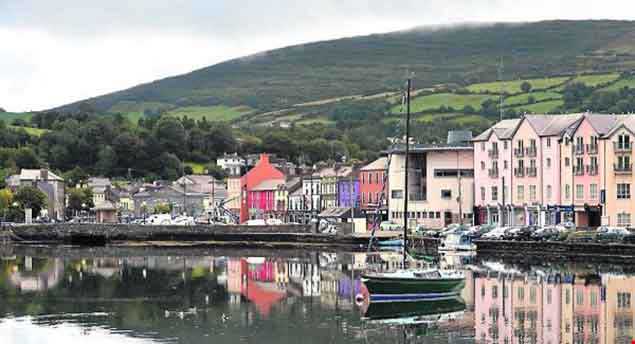 Bantry as it has been until this year – the harbour is now being transformed to make it much more user-friendly for recreational sailors
Bantry as it has been until this year – the harbour is now being transformed to make it much more user-friendly for recreational sailors
Celebrity Chef Rachel Allen cooked up a storm and had everyone eager for an early lunch as she elegantly and efficiently filleted a fresh plaice while entertaining the room with talks of the foods available along the coast and how to prepare them. Butter sizzled and the plaice was seared, dressed with fresh lemon and parsley and tasters were served around the room. Followed by some good tips on the preparation of fresh mussels as she cooked them off with cream and wild garlic pesto – delicious. Rachel then gave personal message book signings as the sailors queued up to buy themselves her cookbook “Coast” all about the foods of south and west coast.
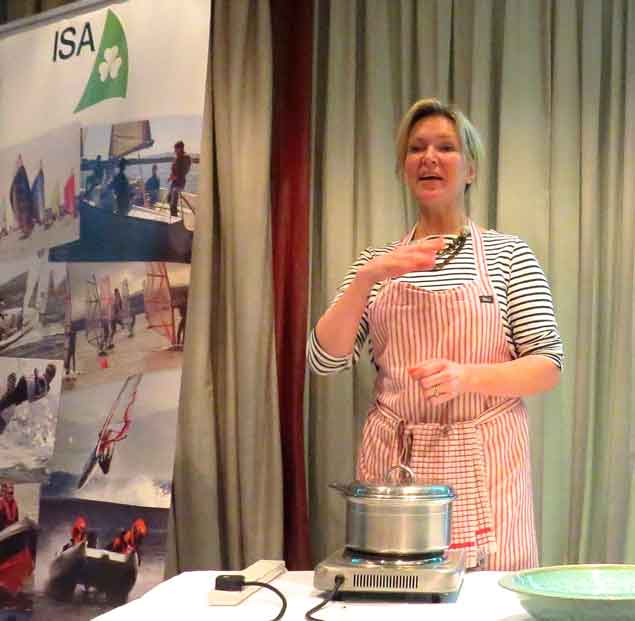 Celebrity chef Rachel Allen’s demonstration was of double interest, as she’s from a sailing family
Celebrity chef Rachel Allen’s demonstration was of double interest, as she’s from a sailing family
Myra Reid had the audience inspired by her story of her sail round the world with husband Pairaic O’Maolriada on their Amel Super Maramu Saol Eile, an achievement which made them Afloat.ie “Sailors of the Month” for July 2016 when they returned successfully to Kinsale.
“Around the world in 80 Days (+1,724)” was the title on the presentation slide. Pairaic and Myra were introduced to boating in 2003, started learning in 2004 and in 2005 Pairaic announced he would rather like to sail round the world, and so their project began.
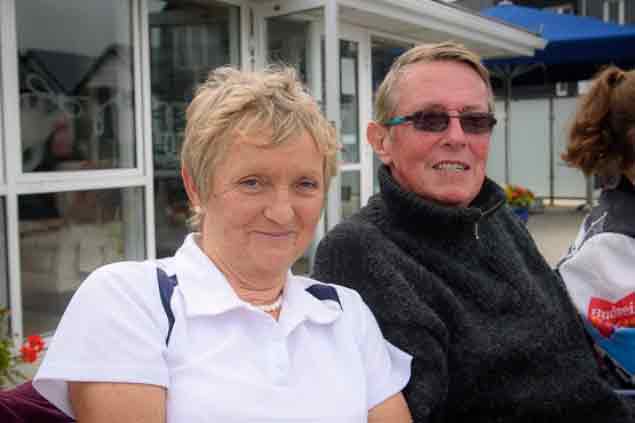 Myra Reid and Pairaic O’Maolriada on their return to Kinsale in July 2016. Their six year global circuit cruise “under the radar” is deservedly becoming the stuff of legend. Photo Robert Bateman
Myra Reid and Pairaic O’Maolriada on their return to Kinsale in July 2016. Their six year global circuit cruise “under the radar” is deservedly becoming the stuff of legend. Photo Robert Bateman
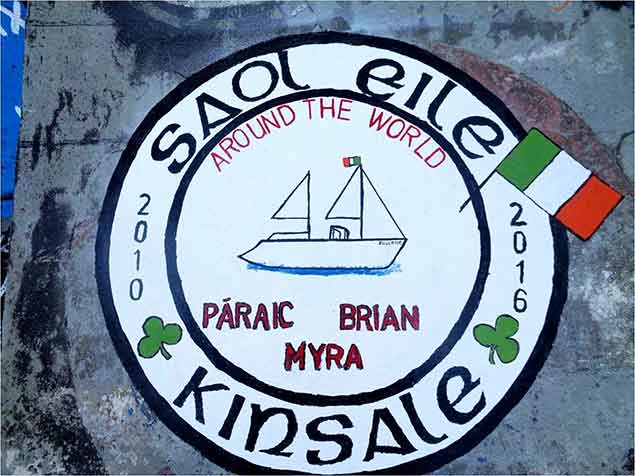 “We were here” – Horta in the Azores was Saol Eile’s last major port of call before returning to Ireland
“We were here” – Horta in the Azores was Saol Eile’s last major port of call before returning to Ireland
As novice sailors, training was their priority and they both embarked on 5 years of knowledge building and training, from skippering to sea survival. Myra entertained the enthralled audience with their tales of deep sea fishing, Panama Canal adventures, Pacific island life and much more.
After all that talk of adventure, Sean O’Farrell of Courtmacsherry RNLI shared some good sound advice on how to avoid a call out. Did you know the main causes of distress are mechanical or structural, fuel, weather, injury or illness and lack of experience or training? Training and the correct equipment on board can help all sailors be prepared for the unexpected.
Evie Conway of Union Chandlery shared her personal experience of falling overboard in Cork Harbour in the winter and left us all in no doubt that without her fully serviced life jacket she might not be with us today. The advice from the RNLI on whether or not to call is “If in doubt, call them out”. Respects were paid to Caitriona Lucas, mother of two and volunteer for Doolin Coast Guard, who during the past year lost her life in service of saving others.
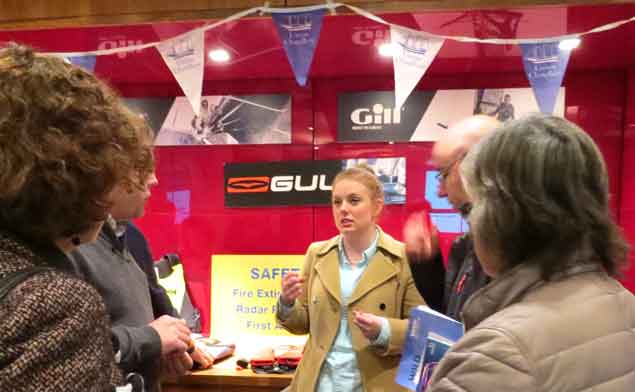 Evie Conway of Union Chandery providing informed insight
Evie Conway of Union Chandery providing informed insight
Deirdre Lane of the Commissioners of Irish Lights took us on a tour of the lighthouses and navigational aids round Ireland, sharing her broad knowledge of how the network of weather buoys, synchronised buoys, virtual buoys and beacons all combine to give cruising sailors safe passage, and gave us a tip to keep a close eye on e-Navigation as the future for navigation communications.
John Leahy, airline pilot, yachtmaster and secretary for the Cruising Association of Ireland, gave an in-depth explanation of Ireland’s weather systems and how to work out your own forecast from some basic understanding of weather fronts and how they progress.
The day closed with the knowledgeable Norman Kean of Irish Cruising Club Publications and Fellow of the Royal Institute for Navigation explaining the “Strange Tides of Ireland” or for those more in the know, the “Amphidromes”, the points where the range of the tide is zero, and the effect that has on the sea. For those who mightn’t believe such places exist, there’s one near Courtown on the Wexford coast, and another between Rathlin Island and Islay in the Western Approaches to the North Channel.
 The goodies….the Irish Cruising Club’s Guide to Paradise (aka The Sailing Directions for the South and West Coasts of Ireland) is edited by Norman Kean.
The goodies….the Irish Cruising Club’s Guide to Paradise (aka The Sailing Directions for the South and West Coasts of Ireland) is edited by Norman Kean.
Throughout the conference Evie Conway was at hand to give expert advice on safety equipment, ICC publications were available to purchase and the team from Clean Coasts gave guidance on the impact of different types of refuse that may find itself overboard on to our beautiful coasts.
 Cruising Association of Ireland Commodore Clifford Brown (left) with fellow members Sue Parker, Charlie Kavanagh, and Simon Parket
Cruising Association of Ireland Commodore Clifford Brown (left) with fellow members Sue Parker, Charlie Kavanagh, and Simon Parket
The incredible energy and passion for their subjects from each of the volunteer speakers, and the genuine interest from the sailors, truly brought this conference to life. Roll on the 2018 Cruising Conference, it’s provisionally scheduled for February in Dublin, while 2019’s is penciled in as February in Galway.
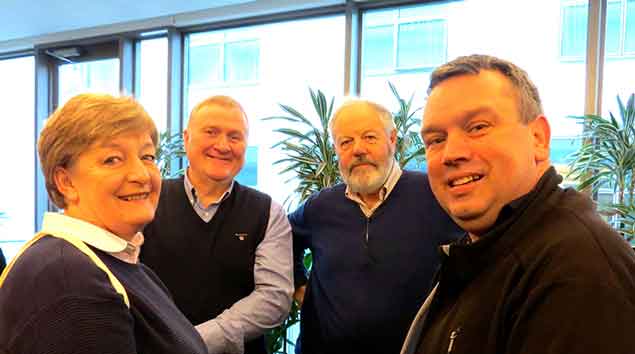 Rosemary Roy with Jack Roy & Paddy McGlade of the ISA Board of Directors, and Gearoid O’Riain of Scouting Ireland, at last weekend’s Cruising Conference in Cork
Rosemary Roy with Jack Roy & Paddy McGlade of the ISA Board of Directors, and Gearoid O’Riain of Scouting Ireland, at last weekend’s Cruising Conference in Cork
Purchase the ICC Cruising directions here
Sailing is Recovering After 'Famine Years' Says ISA CEO
Sailing is in recovery mode after six or seven years of famine. That is the opinion of the Chief Executive of the Irish Sailing Association, Harry Hermon.
This week he told me frankly that the sport had struggled over the past few years, particularly from the effects of the recession. Yacht clubs had suffered and the larger clubs had been hit hard he said. But over the last year or two more boats and more people have come into the system.
“There is more positivity out there now and that is really good. Things are looking good at the moment.”
Sailing has been bedevilled by the image of being an elitist sport and he said that the ISA was dealing with this.
Listen to my interview with Harry Hermon here on this Podcast edition of THIS ISLAND NATION maritime radio programme below which also hears from a company on the East Cork coastline that is setting new trends in the design of special boats including one with “stealth” capabilities to conceal its presence when used by security, Naval and military forces Safehaven Marine at Youghal is also planning to set a new speed record around Rockall this Summer, which are outlined by the man who set it up, Frank Kowalski.
London 2012 Olympic Games Race Officer Jack Roy, who is DBSC Principal Race Officer and ISA Director of Racing, is organising an ISA Race Officer Level 1 Course which will be run over two evenings – Tuesday March 28th and Tuesday April 4th in the National Yacht Club from 7pm to 10pm.
The course is a basic introductory course and is the first step on the road to becoming a Local Race Officer with the ISA. Each course participant will receive a certificate and this is the first step on the ISA Race Officers Pathway programme. Having successfully completed the course participants will be permitted to use the ISA Passport system which is an online logbook that records progress through the 5 disciplines of race management.
Jack will include some material specific to DBSC race management procedures and requirements. We would like to encourage anybody interested in race management to attend the course. For those who already have some experience it is an opportunity to complete the first step of the Race Officer Pathway programme.
The cost of the course is €20. You can register and pay online via the following link on the ISA website here
If you require any further information please contact Sarah-Louise Rossiter, ISA, email [email protected], or Ann Kirwan, DBSC, email [email protected]
Irish Sailing's Silent Cruising Majority Are Vocal This Weekend
Cruising is the side of sailing which sometimes finds it difficult to make its voice heard. Its essence is in the quiet enjoyment of seafaring and the peace of secluded anchorages. Unlike the absolute clarity of racing results, which create their own noise and are energised by a sense of competition with others, cruising folk are in competition mainly with themselves, and with their own self-reliant ability to see a voyaging venture brought to a successful conclusion. W M Nixon takes us through a weekend which is cruising-oriented, and concludes tomorrow with a celebration at the home port of Irish cruising’s most legendary figure.
In previewing the prospects for the sailing season of 2017 a couple of months ago, we suggested that it would be The Year of the Everyday Sailor. For inevitably, 2016 was a year of the high profile happenings featuring superstars, events such as the Volvo Round Ireland Race from Wicklow, the KBC Laser Radial Youth Worlds in Dun Laoghaire, and the absolute peak in Rio de Janeiro, Annalise Murphy’s Olympic Silver Medal.
But 2017 sees a total change of emphasis. With a clear two or three years before the 2020 Olympics start to come up the public agenda again, it’s time to savour and enjoy the sort of sailing most of us do all the time. Local events, neighbourhood regattas, regional offshore and club racing, and that most indefinable of all waterborne activities - cruising.
Last night in Dublin, the Irish Cruising Club held its Annual General Meeting and Prize Giving in which the logs of outstanding cruises – activities which usually stay well under the radar – were given full recognition.
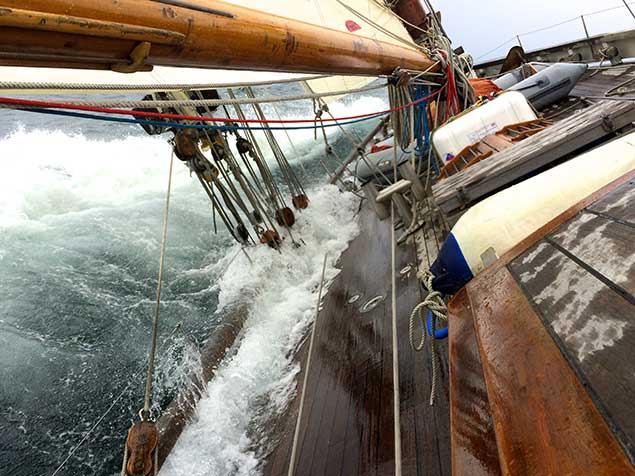 The rugged power of a seaworthy vessel – Annabelle J on passage from Smerwick Harbour in the Dingle Peninsula to Kilronan in the Aran Islands during her 2016 cruise on Ireland’s Atlantic seaboard Photo: Maire breathnach
The rugged power of a seaworthy vessel – Annabelle J on passage from Smerwick Harbour in the Dingle Peninsula to Kilronan in the Aran Islands during her 2016 cruise on Ireland’s Atlantic seaboard Photo: Maire breathnach
Today in Cork, the Irish Sailing Association/Cruising Association of Ireland Annual Cruising Conference is being staged, and it has attracted so much interest that the venue has had to be moved to larger premises than originally planned. As last night’s ICC AGM was a distinctly crowded affair too, clearly the interest in cruising is stronger than ever. But quite how many have managed to attend both events we won’t know until this morning, yet it’s just about possible with a bit of early morning discipline.
Then tomorrow, the focus swings northwestward from Cork to Foynes on the Shannon Estuary, where a Family Day from 2.30pm to 5.30 pm sees a celebration of Foynes Yacht Club becoming the new Volvo ISA Training Centre of the Year, with ISA President David Lovegrove doing the honours for a club which is the very essence of voluntary enthusiasm and community spirit.
Of course, many of the 200 or so young people who emerge from the Foynes Yacht Club Sailing Academy hope to go on to the highest level of racing success. But equally, they will find their talents in sailing much appreciated aboard keenly-sailed cruising boats. And the club has a solid record in offshore racing, with FYC’s Simon McGibney the current Commodore of the Irish Cruiser Racing Association, while father-and-son team Derek and Conor Dillon from Listowel have sailed their Dehler 34 under the Foynes colours to win the two-handed division in the Round Ireland Race.
And then beyond that, Foynes was home port to the great Conor O’Brien (1880-1952) of 1923-1925 Round the World fame. He lived out his final days on Foynes Island, and is buried in the nearby churchyard, but the recently-confirmed plans to build a replica of his famous 40ft ketch Saoirse in her 1922 birthplace of Baltimore will draw further favourable attention to everything that Foynes has done, and is doing, for Irish sailing – racing and cruising alike.
It’s all interconnected, for when the Irish Cruising Club was formed in Glengarriff on Bantry Bay on 13th July 1929, one of the first things they did was make Conor O’Brien an honorary member, and the first time I saw the noted portrait of Conor O’Brien sketched by his wife Kitty Clausen, it was in Foynes YC more than a few years ago..
 Always remembered. The model of Saoirse in Foynes Museum reminds us that she will soon be re-created full size
Always remembered. The model of Saoirse in Foynes Museum reminds us that she will soon be re-created full size
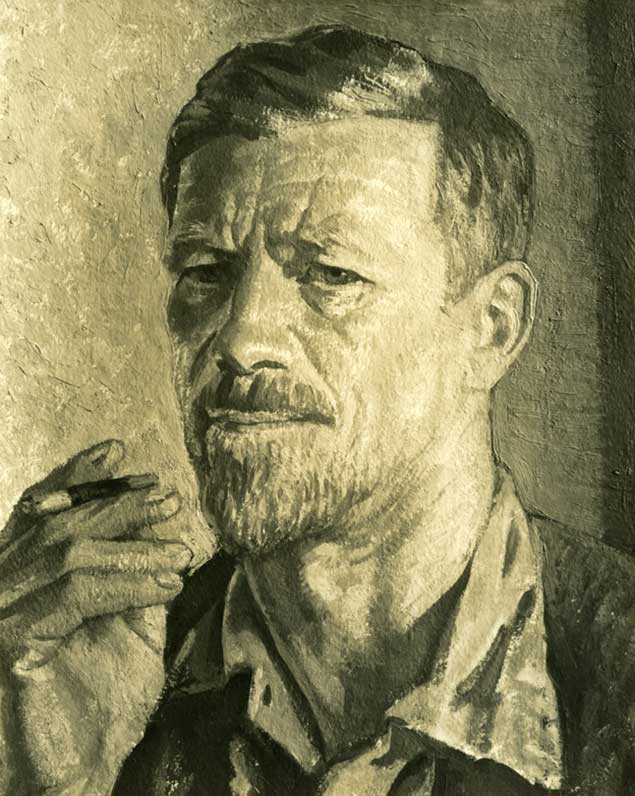 The portrait of Conor O’Brien by his wife Kitty Clausen, seen for the first time in Foynes Yacht Cub.
The portrait of Conor O’Brien by his wife Kitty Clausen, seen for the first time in Foynes Yacht Cub.
So last night’s ICC post-AGM dinner was well peopled with friendly ghosts, but as well it was a celebration of some really remarkable cruises on every scale. Then too, it marked two significant changes of the watch with Peter Killen of Malahide, who led by example with his Amel Super Maramu 54 ketch Pure Magic seemingly always on the move, retiring as Commodore to see the to post go north to Stanton Adair of Belfast Lough, a long-serving committee member and flag officer who will be leading his members in the ICC Cruise-in-Company to the Galician Rias of Northwest Spain this summer in his well-travelled Beneteau Oceanis 43 Grand Cru.
However, while Commodores and other top officers may be the public face of the ICC, the strength of the club is in its voluntarily-produced publications, with Honorary Editors who between them keep the two volumes of Sailing Directions for the entire Irish coast up to date with notable rigour, and produce an Annual journal of the club’s cruising logs.
Norman Kean of Courtmacsherry is very much in charge of the Sailing Directions which are publicly available, and he’ll be one of the keynote speakers at today’s conference in Cork. But in their way the logs in all their rich variety in the Annual can be every bit as informative, particularly as the club is now so far-ranging that its members can be found cruising on most of the planet’s oceans.
Here, there has been another change of the watch, with Ed Wheeler from he north producing his final and as ever excellent Annual to cover the 2016 season, and after four years he hands over to noted sailor/musician/writer Maire Breathnach of Dungarvan. Or at least she’s from Dungarvan and she spends about a third of her time there, but as she’s married to another formidable voyager, Andrew Wilkes of Lymington on the south coast of England, they spend about a third of their time there, where - with other Irish ex-Pats - they’ve created a sort of West Hampshire Gaeltacht.
 Maire Breathnach off Cape Horn at the helm of Andrew Wilkes’ Swan 44 King of Hearts during their cruise round South America in 2004. Photo: Andrew Wilkes
Maire Breathnach off Cape Horn at the helm of Andrew Wilkes’ Swan 44 King of Hearts during their cruise round South America in 2004. Photo: Andrew Wilkes
 The new girl in town. Annabelle J as seen recently from Reginalds Tower in Waterford, with the sail training ketch Brian Boru astern. Photo Maire Breathnach
The new girl in town. Annabelle J as seen recently from Reginalds Tower in Waterford, with the sail training ketch Brian Boru astern. Photo Maire Breathnach
However, the remaining third of their time is maybe most interesting of all, as its spent aboard their gorgeous 55ft gaff cutter Annabelle J, which they bought about 18 months ago to replace their steel gaff yawl Young Larry, with which they’d transitted the Northwest Passage.
The 1996 steel-built Annabelle J first entered Irish maritime consciousness during her previous ownership in 2013, when she was undoubtedly the Queen of the Fleet during the Old Gaffers Golden Jubilee Cruise-in-Company, which took in both Dublin and Belfast. However, if you’ve progressed along the waterfront in Waterford recently, you’ll see her there near Reginald’s Tower, berthed just ahead of the Sail Training ketch Brian Boru, for she’s simply too big to fit into the handy little pool just below the bridge in Dungarvan which Young Larry used to make her winter home.
Although she’s “only” 55ft long in overall hull length, Annabel J is 66ft from nose to tail with spars included, and she speaks “ship” rather than “yacht”. The basic design was by David Cox completed by Gary Mitchell and she was constructed by shipbuilders A & P of Appledore in Devon. Yet while they admit to Bristol Pilot Cutter influence on her design, the original owners made no direct claims for this, but the fact is that she’s such a strikingly handsome vessel that it’s difficult not to see her as the definitive modern version of a pilot cutter, even if she’s larger than most of the original Bristol Channel boats.
For Maire and Andrew, taking on such a vessel was a leap in the dark until they could be confident they could handle her with just the two on board, but a cruise of Ireland’s west coast to Donegal and back in 2016 – including a transit of the Joyce Sound pass inside Slyne Head – showed them they could manage her both in confined waters and at sea, so for 2017 the far horizons call.
However, for 2017 there’s also the additional challenge that Annabel J is now editorial headquarters for the most important annual record of Irish cruising achievement, but her crew being aces in the communications business, they’ll take it all in their stride even if Ed Wheeler has left a very high standard to maintain.
For his final edition of the Annual, the adjudicator for 2016’s logs was former Commodore Cormac McHenry, himself a Transatlantic veteran, and although the ICC now has an enormous selection of trophies to highlight various specialities of achievement, nevertheless he had to by-pass some very notable cruises in order to make his final selection.
The ICC’s premier trophy, dating back to 1931, is the Faulkner Cup, and its latest award is to Daragh Nagle, a member based in Victoria on Canada’s west coast, from where he cruises extensively with his wife Cathy and others in his 1987-built Moody 376 Chantey V.
 Cathy & Daragh Nagle aboard Chantey V in the Sea of Cortez on the west coast of Mexico.
Cathy & Daragh Nagle aboard Chantey V in the Sea of Cortez on the west coast of Mexico.
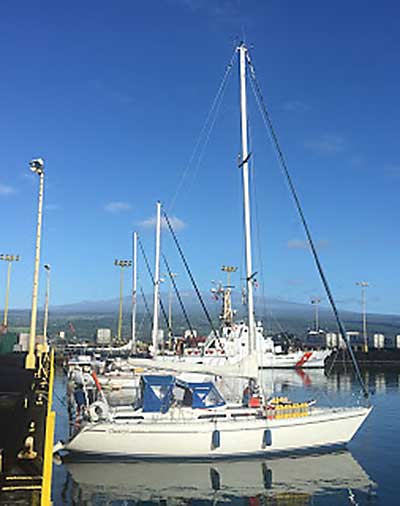 Chantey V is a standard Moody 376, designed by Bill Dixon and built 1986.
Chantey V is a standard Moody 376, designed by Bill Dixon and built 1986.
Chantey V’s 2016 cruise was from San Salvador on the Pacific Coast of Central America northwest along the Mexican coast to the long inlet of the Sea of Cortez, followed by the big ocean hop to the Hawaii Islands, before heading eastward back to Canada.
For the long haul out to the islands, he recruited Portuguese-based ICC member John Duggan as first mate, a role he filled with added diligence as he also obligingly wrote up the log of that stage of the voyage – other first mates please note. And as his skipper was unable to collect the Faulkner Cup last night in person as he is at a family wedding in Malaysia, John Duggan was in Dublin last night to do it for him.
His views on the Pacific between West Coast America and Hawaii were interesting. He says it may seem Pacific after you’ve battled your way round Cape Horn, but by comparison with his usual Atlantic stomping grounds, it seemed an oddly unsettled area of water, with twitchy little waves patterns running every which way.
 Man aloft. Daragh Nagle rigging an emergency inner forestay in mid-Pacific. Photo John Duggan
Man aloft. Daragh Nagle rigging an emergency inner forestay in mid-Pacific. Photo John Duggan
In fact, the going was so jerky at times that Chantey V broke her baby stay. The word from riggers is that the shorter the stay, the less able it is to absorb sudden snatches in loading. But whatever caused it, Darren Nagle spent a few hours getting well bruised at the lower spreaders before he’s rigged a satsfactory temporary baby stay to the stemhead to keep the rig in place for the rest of the voyage. By the time Chantey V got back to Victoria, this cruise totalled 7,858 miles for 2016, and just under 25,000 miles since they started their North America circuit three years ago.
As it happens, the Strangford Cup for an alterative best cruise goes to a venture which John Duggan has done a couple of times with his own 40-footer Hecuba, from the Iberian peninsula out to the Azores and then cruise in detail before returning to Spain or Portugal. In 2016 this very Atlantic cruise was undertaken by Seamus OConnor with his new Hallberg Rassy 42, and with three weeks in the Azores, he produced a mass of interesting information in addition to obviously enjoying himself, which is really what cruising is supposed to be all about.
Enjoyment takes many forms, yet cruising to northeast Greenland would not be many people’s first choice. But Brian Black of Strangford Lough finds he’s drawn back there seemingly year after year in his fairly standard 1985-built Trident Voyager Seafra. He writes of it in such an unassuming yet elegant way that his cruise first to the Faeroes then eastward of Iceland to Ittoqqortoormiit in northeast Greenland (it’s just south of the latitude of Jan Mayen) wins him the Wild Goose Cup for a log of real literary merit, and in it he finds the time to tell us of gig racing in the Faeroes and a visit to his favourite Arctic anchorage of Jyttes Havn.
 Gig racing in the Faroes as watched by Brian Black while cruising towards northeast Greenland. Photo: Brian Black
Gig racing in the Faroes as watched by Brian Black while cruising towards northeast Greenland. Photo: Brian Black
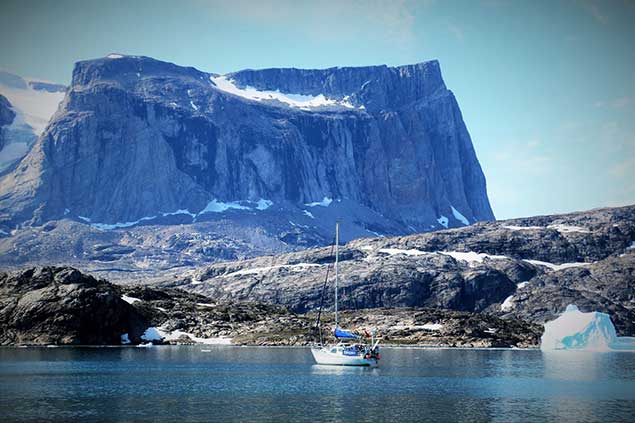 Favourite Arctic anchorage. Seafra in Jyttes Havn, Greenland. Photo: Brian Black
Favourite Arctic anchorage. Seafra in Jyttes Havn, Greenland. Photo: Brian Black
The sun may have shone for Seafra in Jyttes Havn, but far to the southwest in Labrador, Neil Hegarty and his shipmates on the Dufour 34 Shelduck found the weather classic Grand Banks cold and foggy as they readied their Dufour 34 Shelduck for a rugged but efficient passage to Baltimore in West Cork via Newfoundland to complete a three year Atlantic circuit which has been already been garlanded with awards, and now adds the Atlantic Trophy to its laurels.
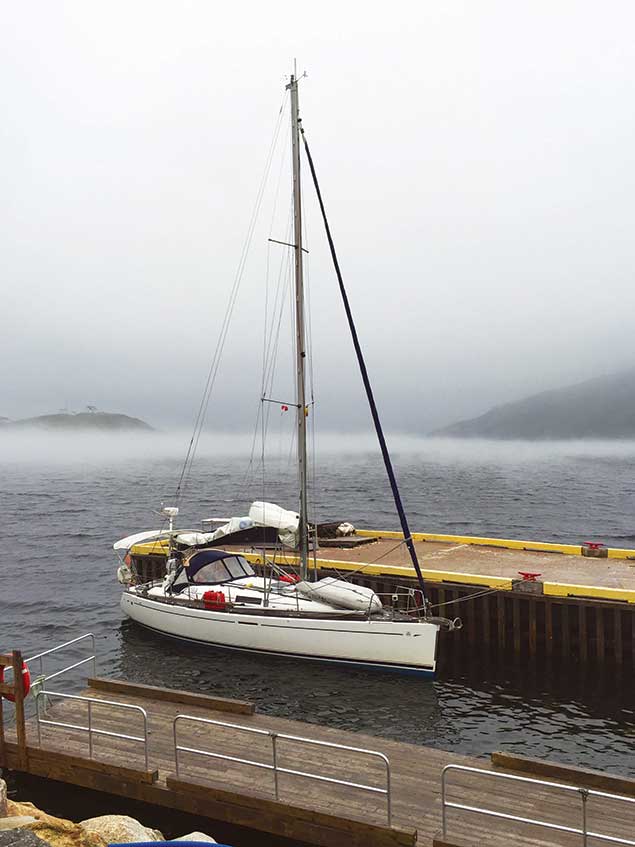 Cold and foggy. Neil Hegarty’s Shelduck at Red Bay, Labrador. Photo Neil Hegarty
Cold and foggy. Neil Hegarty’s Shelduck at Red Bay, Labrador. Photo Neil Hegarty
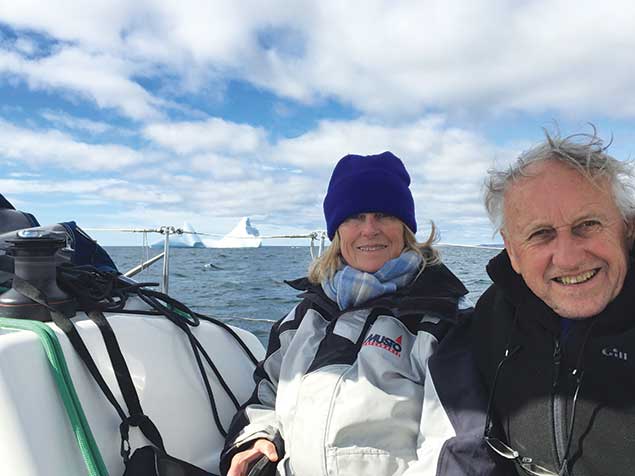 Homeward bound. Neil Hegarty (right) with Ann Kenny of Tralee and icebergs off St Anthony, Newfoundland
Homeward bound. Neil Hegarty (right) with Ann Kenny of Tralee and icebergs off St Anthony, Newfoundland
Even the briefest summary of the other main awards doesnl’t do them justice, but it gives some idea of the ICC’s level of activity:
Fortnight Cup: Best cruise within 16 days, Adrian & Maeve bell of Strangford Lough in the Baltic with their Arcona 430 Oisin Ban.
Round Ireland Cup: Donal Walsh of Dungarvan with his newly-acquired Ovni 385 Lady Belle. Thanks to his new boat’s lifting keel, not only was he able to explore shallow ports seldom visited such as Belmullet and Donegal town, but the fact that an Ovni is well able for seafaring meant he made St Kilda part of a round Ireland cruise while he was at it.
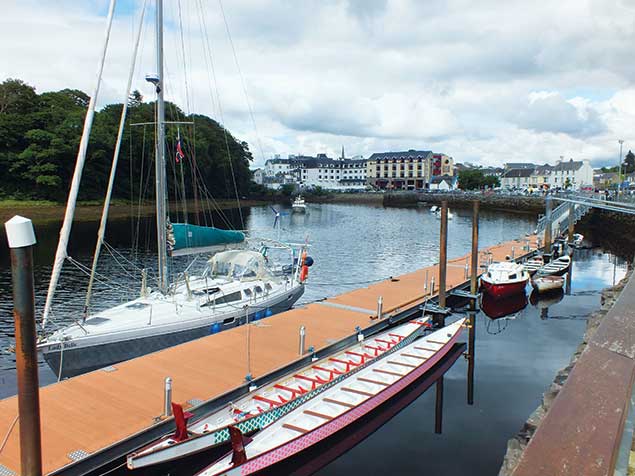 Donal Walsh’s newly-acquired Ovni 385 Lady Belle showing her versatility by comfortably finding enough water with keel raised to visit Donegal town (above), while she also made the passage out to St Kilda (below) with no bother. Photos Donal Walsh
Donal Walsh’s newly-acquired Ovni 385 Lady Belle showing her versatility by comfortably finding enough water with keel raised to visit Donegal town (above), while she also made the passage out to St Kilda (below) with no bother. Photos Donal Walsh

Fingal Cup: for the log which the judge most enjoyed goes most deservedly to Peter Fernie of Galway for a cruise round Ireland with co-owner Dave Whitehead in the Moody 27 Mystic. At least, it was basically round Ireland, but they also took part in the RUYC 150th Anniversary Cruise-in-Company with the ICC and the Clyde Cruising Club to Tobermorey, so through the minimum round Ireland circuit is 704 miles, the little Mystic had logged 1,228 miles by the time she got back to Kinvara.
Despite its many global adventures, the West Coast of Scotland still figures large in ICC activity, and it has its own trophy, the Wybrants Cup, awarded in 2016 to Robin & Denise Wright for a Hebridean jaunt including St Kilda in their 12m Jeanneau Geronimo.
And the charms of the Irish coast aren’t forgotten, they have their own Glengarriff Trophy, and most approoriately for 216 it goes to the new Annual Editor Maire Breathnach for her account of the mighty Annabel J’s stately progress up and down the Atlantic seaboard.
In fact, the Annabel J is the largest of the award winners this time round, and despite her traditional appearance, she’s also one of the newest. So anyone who has an image of the ICC as large glossy new yachts tearing about the ocean is somewhat mistaken, and the club makes a point of honouring its relatively humble origins with the Marie Trophy for the best cruise by any boat under 30ft. It celebrates the little 1893-built gaff cutter Marie which was the first awardee of the Faulkner Cup way back in 1931, and 85 years later, the Marie Trophy goes to Conor O’Byrne for his cruise from Gaway to the cruising paradise of southwest Ireland in the 1986-built Sadler 26 Calico Jack.
It says everything about the ICC’s breadth of achievement that the awards are only the tip of an iceberg of seagoing coasting and island-hopping variety. One particularly notable cruise which didn’t get any nod of special recognition was from Galway Bay to Russia by Fergus and Katherine Quinlan with their own-built van de Stadt 12 metre steel cutter Pylades, a wonderfully detailed account of many countries which contrasts very vividly with their previous big venture, a voyage round the world.
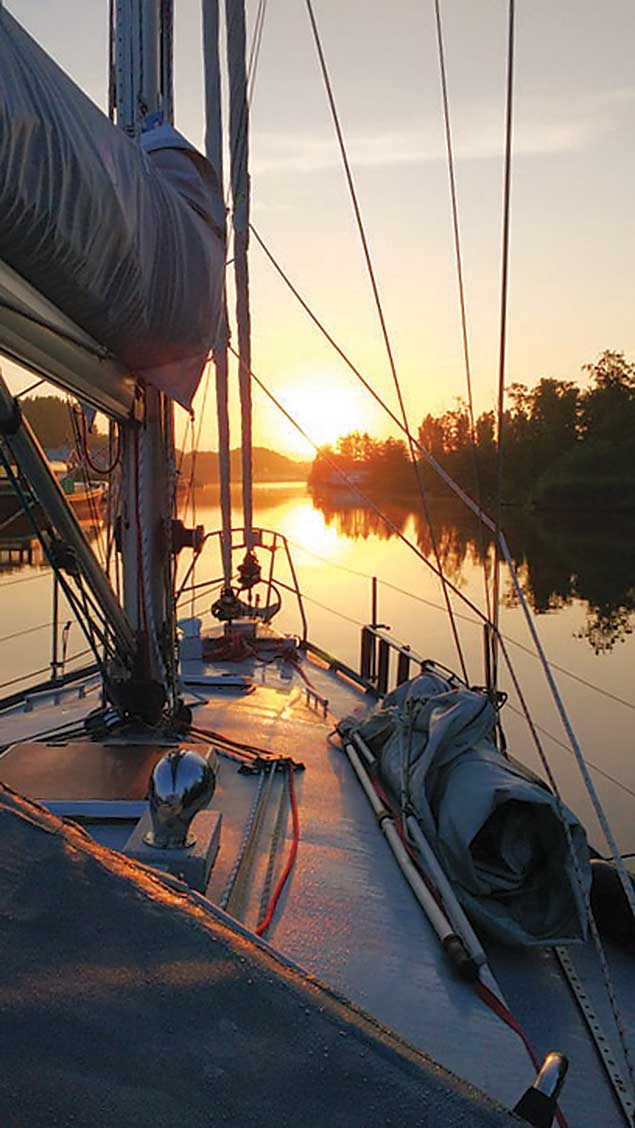 A long way from Pacific Islands. Dawn beyond the Ijsselmeer in the Netherlands, as seen from Pylades during the cruise to Russia. Photo: Fergus Quinlan.
A long way from Pacific Islands. Dawn beyond the Ijsselmeer in the Netherlands, as seen from Pylades during the cruise to Russia. Photo: Fergus Quinlan.
But then that world circuit saw Pylades being awarded the Faulkner Cup three years on the trot, so maybe there’s room for a new trophy “For A Cruise Which Is As Different As Possible From The Same Vessel’s Previous Award-winning Cruise”.
And then there’s no award for a cruise which provides photos which best capture the sprit of a cruising area, but for 2016 it would have gone to Paul Newport of Howth, whose cruise his wife Fiona to the Hebrides with the Najad 332 Puffin Eile was not only a gem of its type, but he brought back a couple of photos which make the place live for the rest of us.
The more dramatic is taken into the sun at Cragaig Bay on the island of Ulva west of Mull, with the distinctive Dutchman’s Cap island in the distance. In the foreground are four cruising yachts, all lying to their own anchors in the approved manner, all at a distance from each other which is enough for politeness and privacy, yet they’re not so far apart that there can’t be some sociable interchange if it is mutually wished.
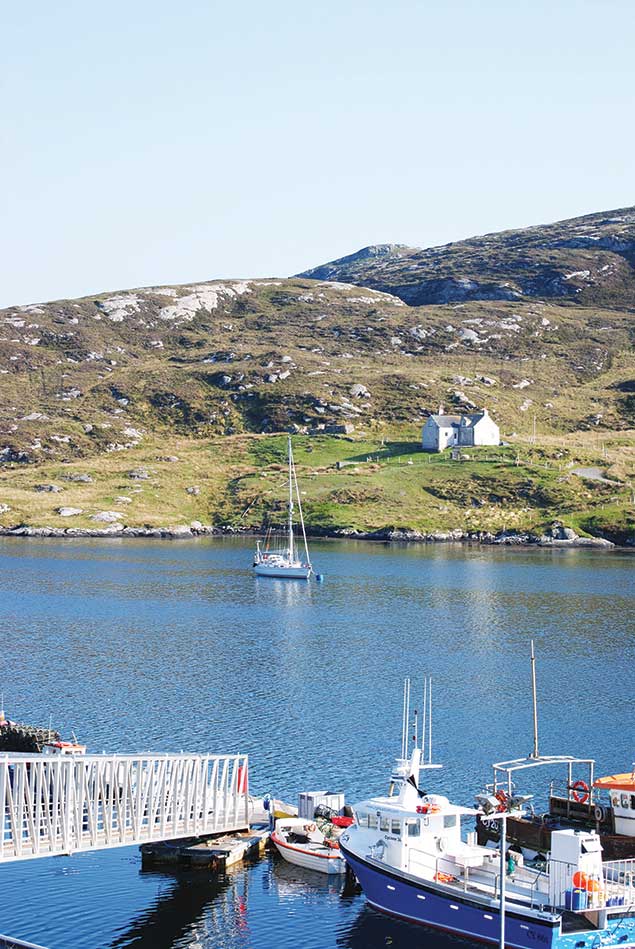 The most perfect small Hebridean island…..Puffin Eile at Eriskay. Photo Paul Newport
The most perfect small Hebridean island…..Puffin Eile at Eriskay. Photo Paul Newport
The other is simply Puffin Eile lying to the visitor’s mooring in the lovely little island of Eriskay. Eriskay is so perfect that when we first went there, one of my shipmates was so impressed that he duly named his next boat after it. Yet somehow timetables in cruising the Outer Hebrides recently have meant that we’ve missed out on Eriskay while passing south or north through the Sea of the Hebrides, so it’s good to see the little place looking so well.
Getting a special satisfaction out of sailing your own boat to places like Eriskay is part of what cruising is all abut. But there are many other factors which contribute to true enjoyment of this mainstream yet low-profile aspect of sailing, and one of them is good food.
So it’s a brilliant idea that Rachel Allen of Ballymaloe should be another of the key speakers at today’s Cruising Conference in Cork. Only recently she featured here in Afloat as Olympic Silver Medallist Annalise Murphy has been doing the intensive 12-week Cookery Course at Ballymaloe, which is definitely not an undertaking for the faint-hearted.
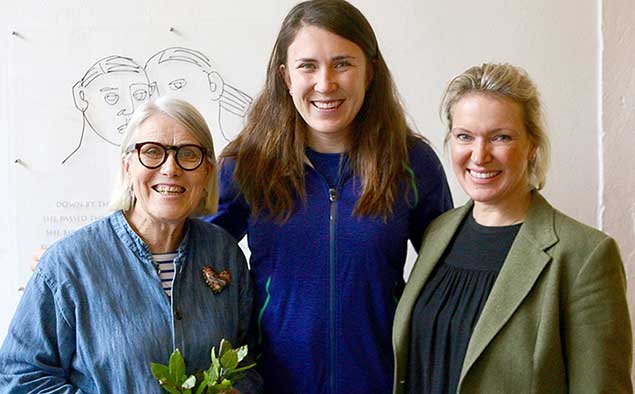 Darina Allen, Olympic Silver Medallist Annalise Murphy, and Rachel Allen at Ballymaloe Cookery School.
Darina Allen, Olympic Silver Medallist Annalise Murphy, and Rachel Allen at Ballymaloe Cookery School.
But Ballymaloe’s connections with sailing are much wider than that, for it was windsurfer Rory Allen of Ballymaloe, who started the famous Round Great Island Race in Cork Harbour scheduled at the top of the tide, and it’s now an annual highlight. And Rachel herself is of the O’Neill sailing family, whom we’ve known afloat for many years. It goes back a very long time to when they’d the Nicholson Half Tonner Silver Mite, and we buddy-boated together from West Cork home to Dublin in good company with Denis and Brian O’Neill. The latter very obligingly hauled one of the Nixon kids out of Kinsale Marina when he fell in while being over-enthusiastic about fishing. I’m happy to tell “Disgusted of Dunmanway” that the young fisherman was wearing a lifejacket, but the O’Neill pull-up was very much appreciated nevertheless.
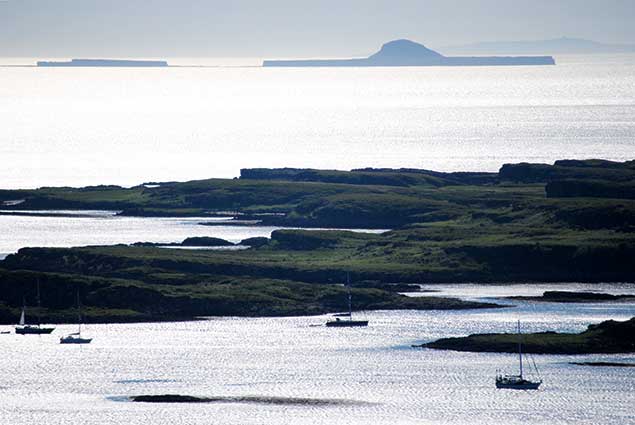 The cruising dream on Scotland’s West Coast. The anchorage at Cragaig Bay on Ulva off the west coast of Mull, with the distinctively-shape Dutchman’s Cap island beyond. Photo Paul Newport
The cruising dream on Scotland’s West Coast. The anchorage at Cragaig Bay on Ulva off the west coast of Mull, with the distinctively-shape Dutchman’s Cap island beyond. Photo Paul Newport
Change of Venue for ISA Cruising Conference
Due to demand for this weekend's ISA Cruising Conference 2017 in Cork city, there has been a change of venue. The one day conference sponsored by Union Chandlery moves from the Port of Cork offices to the Clayton Hotel City Centre, on Lapps Quay. Seats have been released to a waiting list of delegates and additional seating is now available.
'The delegate enthusiasm for the conference and all the speakers is fantastic.' says organiser Gail McAllister.
More details here.
All Ireland Gets Together for Sailing Celebration (Photo Gallery of the Sailor of the Year Awards Here)
In public perception terms, sailing had never been higher on the scale of national interest in Ireland than it was in August 2016 when Annalise Murphy’s Olympic Silver Medal victory had an entire nation and its widespread diaspora on the edge of their seats as the final seconds were sailed out in the Medals Race at Rio writes W M Nixon.
But popular attention is a very fickle thing which has now turned to other matters. And with Annalise Murphy since being garlanded with well-earned major national awards under just about every category you could think of, there wasn’t undue concern that the biggest non-surprise for a long time – her elevation to become the Volvo Sailor of the Year 2016 – would simply be taken for granted, and as such, would be regarded as non-news by mainstream media.
So whether it was a mature acceptance of this reality by sailing’s organizers, or whether or not it was just pure serendipity, is neither here nor there. But the fact is that holding the awards ceremony on the last Friday night of January in Dublin may have been the sentence of death of terms of popular news coverage. But for the true faithful of the sailing community from every last corner of Ireland, it was the perfect opportunity for an extraordinarily diverse crowd of people to gather and celebrate their sport in all its forms, and hail their heroes.
Of course the ultimate spotlights were on our supreme award winner Annalise Murphy, and the Youth Sailor of the Year Ewan MacMahon. But with other youth awards, training centre awards, and the very elastically-interpreted Afloat.ie “Sailor of the Month” awards with 27 winners coming into focus, that same spotlight shone brightly if briefly on remarkable achievements in every part of Ireland and abroad, all of them contributing to the fabulous tapestry which is Ireland’s world of boats.
Normally the world of boats and sailing is well aware that it is a minority sport. But on Friday night, it wasn’t a case of it briefly becoming a majority sport. It was the only sport. The camaraderie was palpable. The shared enthusiasm was energising. And the way that people from near and far instantly connected was heartening to behold.
For me, it was summed up by one brief but eloquent encounter. I was talking with Ted Crosbie, who was Admiral of the Royal Cork in 1984-86, and long before that he was the All Ireland Helmsmans Champion, racing in IDRA 14s in 1950. He was there to see his grand-daughter Sophie receive proper recognition for her achievements in Topper racing. As we chatted, Peter Ryan of the National YC hove into view with his shipmate Stephen Tudor of Pwllheli in North Wales, whose overall victory in the ISORA Championship 2016 with his J/109 made him Afloat.ie “Sailor of the Month” for September.
The fact that a top Welsh skipper should win an Irish Sailor of the Month award says all that needs to be said about the creative flexibility of the Afloat system. But equally, here were two top sailors from very different places and backgrounds and generations instantly hitting it off in their shared joy in our sport. The divine spark was undoubtedly present. It was that kind of night.
OCI Election: Irish Sailing's Colm Barrington Seeks 'Athlete Rather than Official Centred Organisation'
The Irish Sailing Association (ISA) has nominated Colm Barrington (70) as a candidate for 'First Vice President' in February's election of the Olympic Council of Ireland (OCI) Executive Committee. The Irish sailing champion and former Aer Lingus Chairman says he is running 'in support of Sarah Keane's bid to be OCI President and her reform programme'.
The OCI election is shaping up to be a battle between the old guard and those seeking change for an organisation in crisis. For the first time since 1989, long-standing president Pat Hickey will not be running in the election.
Sarah Keane, William O’Brien and Bernard O’Byrne are the candidates who will fight it out for the OCI's top position at next month's meeting.
Barrington, a global aircraft leasing chief, is in no doubt about the work ahead if elected and pulls no punches about the current state of the OCI in the Afloat.ie interview below. His experience is that 'the OCI has done nothing to support the efforts of our high performance sailors'. He also says 'the successes of Annalise and the rest of the team in Rio, and at previous Olympic Games, were despite the OCI and not because of anything they did for us'.
Sailing's sole nomination for the XXXII Olympiad – Tokyo, Japan 2020 executive is running against Irish Taekwondo's Martin Fleming for the First Vice President role.
Barrington, a passionate Irish sports fan, served for 12 years as Chairman of the ISA's Olympic Group stepping down after Rio. He continues to Chair the Irish Sailing Foundation, the Olympic fundraising body for sailing, established by him in 2015.
He maintains Ireland’s success rate at the Olympic Games is not good enough, particularly for a 'sports–mad and relatively well–off nation'.
Irish Sailing's candidate also says he hopes the terms of office of future OCI officials and Executive Committee members will not exceed eight years.
The election will take place on Thursday, 9th February 2017 at the Conrad Hotel, Dublin.
Read the interview below
Afloat.ie: What future direction do you think the OCI should go in?
Colm Barrington (CB): I am passionate about sport and, particularly, about achieving international success. Ireland’s success rate at Olympic Games is not good enough, particularly for a sports-mad and relatively well-off nation. In Rio, Ireland’s two medals put us 62nd in the medals table out of the 87 countries that won any medals. The OCI needs to respond to that situation and assist our athletes, their coaches, their families and their federations to be more successful. Olympic success is the best way to promote the Olympic movement in Ireland. The OCI needs to up its game in this regard.
Assistance needs to include helping federations to bring in the right people for both governance and management and to develop high performance programmes with them. It also needs to include providing appropriate logistical and management support at Olympic Games and focusing on maximising financial support that can be passed on to the athletes and their programmes. The OCI must focus on athletes rather than on itself and its officials. Simple changes, such as making Olympic tickets available to athletes and their families, can help the Olympic movement greatly.
While my main objective would be to help make the OCI a truly athlete centred organisation, I would also aim to bring my corporate experience to help institute appropriate governance in line with best international practise. Specifically, I would plan to oversee implementation of the recommendations of the Deloitte Report.
It is also important that the OCI becomes an important part of Irish social life and an influential supporter of the many benefits of Olympic sport in this country. In this regard the performance and results of the OCI and the GAA are poles apart. I would hope to use my relationships at all levels of Irish and international society to help restore the OCI’s reputation and to enhance its profile with commercial sponsors.
What lessons from your successful work as Chair of the ISA's Olympic Group do you think could be useful for the OCI and other Irish Olympic sports?
CB: I am proud to have witnessed Ireland's high performance sailing programme develop from ad hoc talent management into a high performance system which has produced numerous international successes at junior, intermediate and senior levels and, finally, Annalise’s Olympic medal in Rio after her near-miss in London.
In my experience the Olympic Council of Ireland has done nothing to support the efforts of our high performance sailors. The successes of Annalise and the rest of our team in Rio, and at previous Olympic Games, were despite the OCI and not because of anything they did for us. Indeed, at Rio their arrangements for accommodation, transport and accreditations were useless and we had to make our own parallel accommodation and transport arrangements at an additional cost of €70,000. This was a big part of our 2016 budget and has resulted in corresponding cutbacks in other parts of our HP programme. And it was all as a result of the OCI’s unwillingness to respond to our reasonable requests and to focus on what was needed to support our athletes as they tried to achieve success. I assume that they treated other athlete groups in a similar manner.
The OCI needs to help our sporting federations to institute appropriate programmes to support athletes’ ambitions, to help get the right people to run the programmes and to maximize the funding support that is available for our athletes.
Given the recent changes recommended in the Deloitte report do you consider your nomination to be an engine for change?
CB: There are significant changes required in its governance in order to restore the reputation of the OCI and to ensure that it is regarded among the most respected sports organisations in the country. A strong and respected OCI will be of huge benefit to its member federations and is also vital in maximising the potential of Irish high performance athletes on the world stage. I hope that I can help make this happen. There are many recommendations in the Deloitte report, but I hope that one of their main recommendations - that terms of office of OCI officials and Executive Committee members should not exceed eight years - will be taken seriously by the federations and will apply to the upcoming election.
OCI vice-presidents can go forward for nomination to the Presidency every four years. Is this a role you would consider?
CB: I am running for the position of First Vice President in support of Sarah Keane bid to be President and in support of her reform programme. I believe that I can make my best contribution to the OCI and its member federations by helping change the OCI’s focus to an athlete rather than official centred organisation, by improving governance and by creating openness and fairness. I have no aspirations to be President.
Download the OCI's List of Nominations for Election of Officers and Executive below.
Read more about Colm Barrington's role in Irish Olympic sailing in Afloat's pre–Rio interview here.
Irish Sailing Foundation Honours Olympic Hero Annalise Murphy
#ISF - Rio silver medallist Annalise Murphy is now an honorary member of the Irish Sailing Foundation (ISF) following her incredible Olympic success this past summer.
The announcement comes as the ISF, the new investment support structure for Ireland’s high performance sailing programme, celebrates a year of achievement at every level of competition.
Indeed, Murphy’s medal win wasn’t the only result for Irish sailing in August, with fellow Team IRL members Ryan Seaton and Matt McGovern making their medal race in a final hurrah before their recent split, Andrea Brewster and Saskia Tidey just missing out on their skiff final, and Finn Lynch putting in a strong performance as the youngest in his class in preparation for a medal challenge at Tokyo 2020.
Beyond the Olympics, August was a good month for Johnny Durcan, Fionn Conway and Ronan Walsh, who took second, third and fourth places respectively in the UK Laser Nationals, while Johnny’s twin Harry Durcan, with Harry Whittaker, won the UK 29er Nationals in Torbay, and Tom Higgins sailed the first Irish boat to win the Volvo Gill Optimist National.
Earlier in the summer, there was success for Ireland’s girls in the Topper Worlds at Ballyholme, as Sophie Crosbie, Ella Hemeryck and Jenna McCarlie claimed the podium from gold to silver in that order, though the boys didn’t fare too badly either, with Michael Carroll in fourth and Jack Fahy sixth.
Elsewhere, at the Laser Worlds in Dublin, Nicole Hemeryck — sister of Ella — placed seventh in the U19 girls competition, while Ewan McMahon was second among the boys. Nicole was also second in the under 19s( 13th overall) at the under 21 worlds in Kiel, Germany.
And even earlier in the year, there was a bronze medal for Dougie Elmes and Colin O'Sullivan at the ISAF 420 Youth Worlds in Malaysia, the first ever podium for Ireland in that competition.
Currently all development teams in the Laser, Laser Radial and 49er have moved to Cadiz to escape the cold ahead of January’s annual World Cup in Miami, with further training camps to follow in Spain and Malta in February and March.
But the year isn’t over yet, as Ireland will be represented by Nicole Hemeryck and Johnny Durcan at the Youth Worlds in New Zealand from 14-20 December.
Looking at the longer term, ISA performance director James O’Callaghan will be on hand at a Performance Pathway information meeting at the Royal Cork this Wednesday 30 November where he will discuss, among other things, the results of his recent fact-finding mission to Tokyo.
O’Callaghan was gathering intel on the sailing venue at Enoshima with a view to Team IRL establishing an early base there — identified as one of the keys to Annalise’s medal finish this summer. That will be especially important at Tokyo 2020, where temperatures and humidity will be significantly higher than they were in Rio.



























